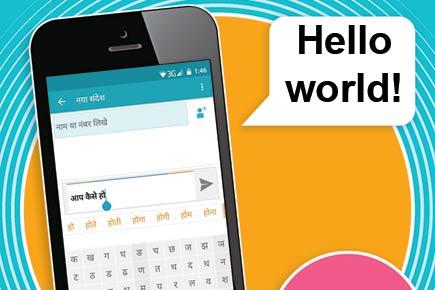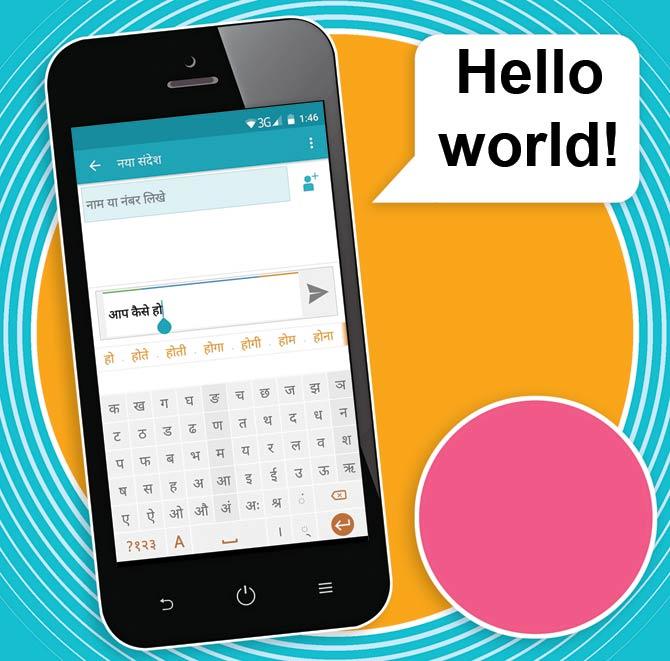Technology firms are creating products in Marathi, Bangla, Tamil and Urdu to increase the reach of smartphones in India

As per Census 2011, 88% of the Indian population does not speak English. Pic/AFP
![]() In October 2015, Google had introduced voice search support for Hindi and Indian English on Android OS in a suburban five-star in Mumbai. Many guests, despite owning the latest smartphones, seemed unaware of common features available on the Android OS.
In October 2015, Google had introduced voice search support for Hindi and Indian English on Android OS in a suburban five-star in Mumbai. Many guests, despite owning the latest smartphones, seemed unaware of common features available on the Android OS.

ADVERTISEMENT
They were surprised to discover functions where they could ask a question to their phones in Hindi or English by merely prompting two words, 'OK Google!' The episode revealed how illiteracy of a different kind exists among India's urban, educated class, and that the language barrier could be a major cause for it. It's a huge vacuum that software developers have begun to fill.
Android in India
Since its arrival, Android has added support for 11 Indian languages, as well as launched the Google Indic Keyboard app, which allows users to input words in these languages using an English keyboard. As for those who wish to type in their native script, there's also the native keyboard mode, Handwriting mode and Hinglish mode. Besides, the Android Marshmallow supports Urdu and Gujarati along with a pre-existing list of Indian languages like Hindi, Tamil, Telugu, Marathi, Bangla, etc, on Android OS.
The company says it's currently working with 30 partners on the Indian Language Internet Alliance (ILIA), launched in 2014, to make the Web more useful to Indic language speakers. "Our strategy is to first crack Hindi, build a successful template, and then scale this template across other major Indian languages over time. We have a team of engineers and business minds across the company and continents working on making our products work in Hindi," Google India reverted, in their official email response.

As per Census 2011, 88% of the Indian population does not speak English. Pic/AFP
The Indian language technology is not about Google alone, though. Apple has already added support for Hinglish to its voice search engine, Siri, and offers support for Indian languages in iOS. Likewise, Microsoft supports around 14 Indian languages in Windows 10 OS as well as its products like Microsoft Office. There are several start-ups, educational institutes, private companies and government organisations working together to create an ecosystem of technology in Indian languages.
Birth of an OS
Back in April 2013, three IIT Bombay graduates — Rakesh Deshmukh, Aakash Dongre and Sudhir Bangarambandi — formed Firstouch (now renamed to IndusOS), after reading a news article on how lack of support for Indian languages was a major hurdle in making India a computer literate society. The company created IndusOS, an Android OS build that supports 12 Indian languages offering regional languages keyboard, text to speech and an app store featuring apps and games in these Indian languages.
Currently, IndusOs is available in 22 device models, and more can be expected. The company recently received a funding of $5mn to scale up operations. "We are working towards increasing our support to 22 Indian languages by 2018," reveals Rakesh Deshmukh, CEO of IndusOS.
In December 2015, the company signed a deal with Department of Information and Technology (DeitY) to introduce native Operating System integrated text-to-speech technology in regional languages. "We are also in talks with other smartphone manufacturers to licence its OS, and will make some announcements soon," adds Deshmukh.
But IndusOS is not the lone player in this field. Smartphone manufacturer Karbonn Mobiles has been working on creating its own OS build with support for Indian languages. The company recently unveiled the K9 Smart for R3,990, equipped with a new Android OS fork with 12 Indian languages at system level, phone/ contacts access in 11 Indian languages, 21 languages typing options and access to popular apps like Facebook, news website, Google Maps, etc, in local languages. "The next wave of growth in the IT industry will not come from the metros, but from small cities and rural areas, majority of whom speak in the regional languages," says Shashin Devsare, Executive Director, Karbonn Mobiles.
The language technology ecosystem
The need to support Indian languages has been a driving force across educational institutes with IIT Bombay and Madras creating language labs where they devise products and conduct research. There is also TDIL and C-DAC under DeitY, which have been creating language-based programmes for non-commercial use. In fact, C-DAC already offers free downloadable keyboards and fonts for Indian languages including the Brahmi script as well as the Nastaleeq script, which solved the problem of font shortage in Urdu.
"Till today, several Urdu keyboards use the Arabic font for Urdu, which are difficult to read and follow for most Urdu speaking population in India. So, while adding Urdu language to our OS, we created a font that resembles Urdu as written in India," reminds Deshmukh.
In 2014, Swathanthra Malayalam Computing (SMC) launched Indic Project, to proliferate Indian languages in smartphones. In April 2014, it launched its FOSS app, Indic Keyboard app on Android. The app, created with financial support from International Centre for Free and Open Source (ICFOSS), Government of Kerala, has been downloaded 4 lakh plus times, and supports 23 languages with 15 inscript (including rare ones such as Manipuri in Meithei script and Santali in Devnagari script) and eight other languages in transliteration mode.
"When we started developing Indic keyboard, the font availability in Android models in india was very low and many manufactures were removing the fonts to reduce memory footprint of the devices . Now the situation has changed with the rise in indian languages. But still, India's 22 official languages are not supported," says Anivar Aravind, Executive Director, Indic Project.
Apart from SMC, there are also companies like Reverie (which helps create multilingual applications and software), HinKhoj (a free online Hindi to English and English to Hindi Dictionary and translation service), Process 9 (a localisation solution provider that enables translation and transliteration across 9 Indian languages) and more.
Localised content and searches
So, what drives these companies to create an ecosystem for Indian languages? According to a report by Ericsson, smartphone penetration in India is expected to grow to 520 mn by 2020.
"The preference of the Indian consumers towards vernacular and regional language content is constantly on the upswing, with 93% of the time spent on videos in Hindi and other regional languages. With an increasing number of users having their own unique needs waiting to be served by technology, support for regional languages becomes imminent for smartphone makers," says Google, adding that in 2015, Hindi content on the Web grew by 94% year-on-year (yoy), whereas English content grow only at 19% yoy.
And now with the availability of Netflix in the Indian market, and Indian content producers like NexGTV looking to scale up their operations, it's expected to grow further. But that's not the only reason. Google informs us that globally, India is the second place for mobile search queries behind the US, and that mobile search overtook desktop search in 2013. "In a country, where only 15% of India speaks English, support for Indian regional languages is a necessity," sums up Deshmukh.
 Subscribe today by clicking the link and stay updated with the latest news!" Click here!
Subscribe today by clicking the link and stay updated with the latest news!" Click here!







